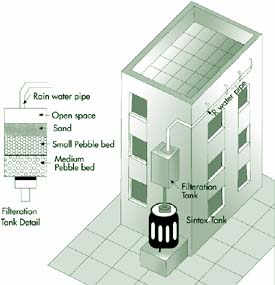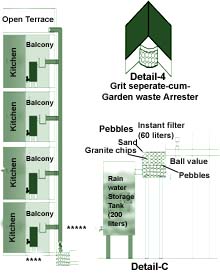|
On the morning of September 27, 1999, residents of Kuil Thottam, a slum settlement in Santhome, Chennai, were in for a pleasant surprise. With first rains after the construction of the storage tank, the rainwater was captured in it. One by one, hesitating at first, as if anybody was watching, the slum residents sampled this water. They were in for an even bigger surprise: they discovered that rainwater was much better than any water they had used earlier. This dream has been realised through the efforts of the Rotary Club of Madras Central and R Jeyakumar, Chairperson, rainwater harvesting programme of the club. This effort has been the outcome of a meeting for builders organised in June 99, by the Chennai-based Tamil Nadu state unit of the National Water Harvesters’ Network (NWHN). This Network is the outcome of the October 1998 CSE’s Conference on Potential of Water Harvesting: Traditions, Policies and Social Mobilisation and has its central secretariat at CSE. The Tamil Nadu state unit is a ‘state unit’ of the NWHN. It is being chaired by Dr. A Vaidyanathan, former Planning Commission member and irrigation specialist. The consistent and dedicated efforts of the branch members have resulted in quick and precise results, because of which the unit is galloping ahead! One of the main recommendations of the builders’ meeting, chaired by Dr A Vaidyanathan, was to undertake a rainwater harvesting project in the slums, primarily to augment water supply as well as reduce the problems associated with waterlogging. The first step was taken by R Jeyakumar, a Rotary club member and a builder in his own right, in mobilising funds from the Rotary Club and constructing a filtration-storage-use water harvesting structure of 3000 litre (150 kodams) capacity in Kuil Thottam. This system, which captures rooftop rainwater, is an extension of the system R Ramani has installed at his residence. Ramani is a member of the steering committee idea, who assisted in the implementation of the system. He has been using rainwater to meet his domestic water demands for more than 4 years now. In Kuil Thottam, there are a total of 320 tenements with 16 tenements per block. The rainwater harvesting technology adopted here as a ‘Model Project’ incorporates a catchment area of approximately 1.85 meters X 1.85 meters on the terrace. The accumulated rainwater is diverted to a separate water pipe, which directs the flow into the filtration tank. The water then passes through the filtration tank and after decontamination, flows into a main tank. The stored water is being used for all domestic applications. The implementers suggested certain precautionary measures to the people and these are being adopted before using the stored rainwater.
The suggestions are primarily to enhance the quality as well the longevity of the water. Apart from the purification performed by the filtration tank, the following procedures are being adopted to improve the water quality:
1500 litres of water got collected in the tank during the first rains after the rainwater harvesting structures was built. Initially there were some apprehensions amongst the implementing agencies whether the slum dwellers would agree to drink rainwater. Nevertheless, the slum dwellers sampled this manna, were happy with the low-cost alternative, as the quality of the water was clearly superior to the usual borewell or tap water. In order to be sure about the quality, subsequently, volunteers of the Rotary Club of Madras Central took a sample of this water to the Chennai Metropolitan Water Supply and Sewage Board (CMWSSB) for testing. There will be 8 such tests through the course of the year, of which two have been completed. As expected, both tests indicated that the quality of water was not only good but also better than borewell or tap water. Encouraged by the results, Jeyakumar is raring to go full steam ahead with a plan to provide rainwater to residents of three entire blocks. Each household in these three blocks would be given a piped connection to the harvested rainwater as Residents of Kuil Thottam, a slum settlement in Santhome,Chennai are happy with the introduction of rainwater harvesting technology. For them, it is a low-cost alternative, which can be replicated.According to them the quality of water is clearly superior to the usual borewell or tap water. well as a 200-litre storage capacity drum. This would cost a total of approximately Rs.1, 00,000 or Rs. 4,200 per tenement. Sharing Jeyakumar’s enthusiasm is the Rotary Governor, Rekha Shetty, who plans to fund 50 % of the project. Not one to be left behind, the Club President Chandrashekar has vowed to look into the possibility of funding the remaining 50 %. There is an intense potential of rainwater meeting drinking and cooking requirements in Chennai. The estimate of water requirement on an annual basis of a single family residing in Kuil Thottam was worked out by Jeyakumar to monitor the utility and effectiveness of the programme. According to the study, a family of five needs 15 litres per day for drinking and cooking purposes. Keeping in view the requirement of the household, the project at Kuil Thottam would be able to meet the annual requirement for water given Chennai’s annual rainfall and the presence of a storage tank of 3000 litres.
For Ulsoor Lake in Bangalore, wallowing in filth, there is still hope. The residents of Bangalore are concerned and motivated enough to translate that concern into action. On June 5 this year, Bangalorians joined hands in a human chain around the lake. The ‘circle of concern’ was organised by the Ulsoor Lake Foundation and the Taj Group of Hotels. The Ulsoor Lake dates back to circa 16th century. In 1866-67, Sir Lewin Bentham Bowring, then British commissioner of Bangalore constructed stormwater drains to carry rainwater and a bund to make this tank a reservoir of potable water. The lake, which was once considered as one of the leading source of potable water, is presently barely recognisable. Large portions of this reservoir are covered with water hyacinth and other weeds. Sewage and industrial effluents have turned the clear waters into a pool of dirty green water. A dip into the waters could mean an attack of scabies or other skin disease. Admiral OP Dawson, former chief of naval staff has been concerned about the growing pollution of the lake and since 1991, he took numerous steps in conjunction with the navy as well as the Military Engineering Group (MEG). Unfortunately, the efforts have not borne fruit. Reports on the hydrological survey by the navy and a survey by the MEG have been forwarded to the Bangalore City Corporation, where these disappeared into the annals of the Corporation. With the lake in dire need of a cleaning operation and Dawson stating that the Navy could offer a hand, what it needs is a sympathetic bureaucracy. Dawson is now spreading the word and getting the Bangalorians to pressurise the government into action mode. Dawson’s campaign is targeted at NGOs, schools and other groups, with the hope that the lake will be restored to its past glory. Seeing is believingParticipants of the Regional Workshop on ‘Civil Society’s Movements for Watershed Management in Asia’ held from March 30 – April 10, 1999, visited three places in India, where prominent civic movements for watershed management have been undertaken. These are Arwari River Basin in Alwar District, Laporiya village in Jaipur District, both in Rajasthan, and the sub-tropical high altitude Doodhatoli range in Pauri District of Uttar Pradesh. These movements have been led by Tarun Bharat Sangh (TBS) in Alwar since the past 13 years, the Gram Vikas Nav Yuvak Mandal (GVNYM) in Jaipur since 9 years, and the Doodhatoli Loka Vikas Sansthan (DLVS), in Pauri, for 25 years. These three locations are characterized by the agro-pastoral lifestyle of the people. In all the areas, the intervention by NGOs included the rejuvenation of traditional village organizations in addition to the physical activities related to construction of water retaining and recharge structures. Adopting such measures enhanced the availability of then a scarce resource, which was the key to the survival of the local settlement. This process was made easier by the presence of dedicated leaders among the people, who acted as facilitators in the process of peoples’ involvement. Furthermore, the activities focussed on people’s empowerment and self-reliance.For almost all the physical interventions (construction of water retaining / recharge structures), these movements depended heavily on indigenous knowledge and locally available skills. The structures were designed by local para-engineers called gajadhars, using traditional techniques, and built by the villagers themselves through shramdan (voluntary labour). The cost of the structures was extremely low. A study by the UN – Interagency of work done by TBS found that villagers’ contribution to the total cost ranged from 60% to 80%. Because of the involvement of the people, the structures are cherished and maintained. The structures have made a significant impact on the people’s livelihoods and the
environment in these areas. In the Arwari River Basin area, at least five rivers, which
were seasonal rivers before the interventions by TBS, have become perennial since 1996.
Due to recharging of the groundwater in the area, water availability for irrigation has
increased, leading to an increase in agricultural productivity. The area of land
cultivated has increased from 20% in 1985 to 100% in 1998, and the number of harvests have
increased two to three folds . The process of water conservation has been accompanied by a
regeneration of vegetation in the areas due to protection and re-plantation. Increase in
availability of fodder has led to a notable increase in cattle rearing, and consequently,
milk production. A social manifestation of the process has been the decrease in seasonal and permanent out-migration, which used to affect 60 to 70% of the population in the areas; presently only 5% of the households migrate seasonally. With the improvement in economic conditions, crime rates have decreased, and education and health consciousness have increased substantially. Women’s empowerment has resulted from the process and girls’ enrolment rate in schools have increased tenfold. The methods employed by all the three Watershed
management initiatives have made significant impact organizations were almost similar. They had adopted various strategies, namely padyatras (long marches on feet) and shivirs (people’s camps). The intentions of these strategies were to motivate people, emphasise on spirituality, involve the decentralised decision making structures and the use cultural mechanisms to ingrain the process of civic participation in decentralised management of natural resources. Source: (ASIAN WATMANET, Newsletter No 19 June’ 99) |
|||||


